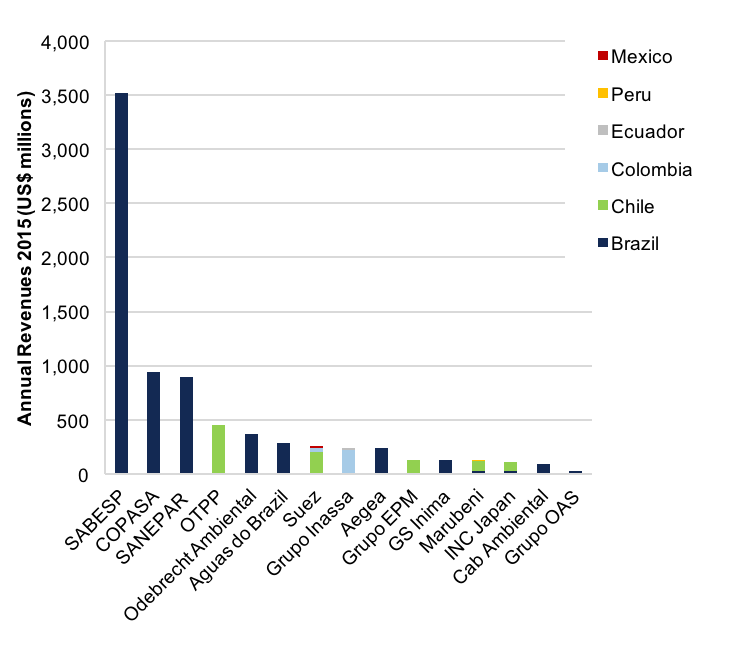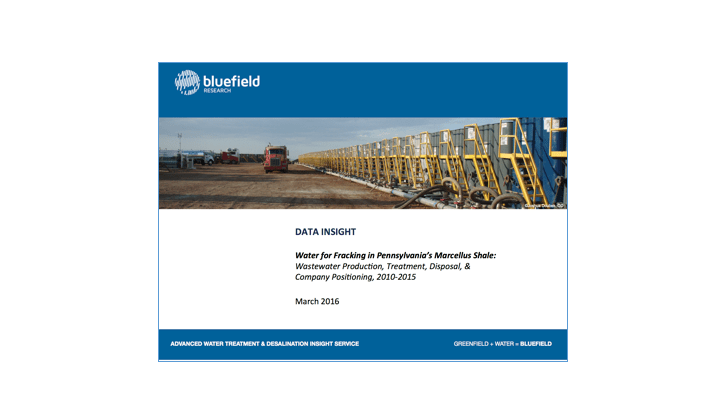Report Type: Insight Report
Deep dive analysis on comprehensive topics to identify market opportunities.
Latin America Private Water Utilities: Company Rankings & Trends, 2016
Bluefield Ranks top 15 Private Water Utilities in Latin America The top 15 Latin American consolidated private water utilities generated a combined US$7.8 billion of revenues in 2015. Weakening of regional currencies and droughts led to a 21% drop from 2014. Brazilian utilities lead the regional ranking representing 9 of the top 15 consolidated private… Continue reading Latin America Private Water Utilities: Company Rankings & Trends, 2016
Renewable-Powered Desalination: Global Market Trends and Drivers
Renewable-Powered Desalination is taking off in emerging markets. Bluefield analyzes trends and drivers Since 2000, 66 renewable-energy-powered desalination plants have been commissioned with a combined capacity of 1.7 million m3/d. Solar and wind energy power 57 of these plants. Almost all of this renewable desalination capacity has been installed in developed countries attempting to offset… Continue reading Renewable-Powered Desalination: Global Market Trends and Drivers
U.S. Investor-Owned Utilities Quarterly M&A Update
Brexit: UK Water Sector Players Brace for Impact
Brexit has injected another level of uncertainty into the municipal water sector, requiring all foreign investors to reassess their UK portfolios. Overall, the municipal water sector responds more gradually to market and policy changes than other sectors, and the AMP6 guarantees predictability in terms of infrastructure investment levels through 2020. However, The UK water industry will… Continue reading Brexit: UK Water Sector Players Brace for Impact
U.S. Municipal Wastewater Reuse: Project Pipeline and Market Update 2016
Our analysis of the U.S. wastewater reuse sector demonstrates a total installed capacity of 18.5 million m3/d and US$12 billion of projects in the pipeline.
Water for Fracking in Pennsylvania’s Marcellus Shale: Wastewater Production, Treatment, Disposal, & Company Positioning
Bluefield Research’s analysis of more than 8,431 well permits for hydraulic fracturing in the Commonwealth of Pennsylvania’s Marcellus Shale highlights…
U.S. Investor-Owned Utilities M&A Update, 2013-2015
U.S. EPA Combined Sewer Compliance: Judicial Consent Decree Trends and Planned Investment
Municipal sewer systems are facing increasing enforcement action and Clean Water Act violations by the Environmental Protection Agency (EPA) to reduce discharges of raw sewage and stormwater runoff. Through the National Enforcement Initiative, the EPA lists 29 civil judicial consent decrees to address combined sewer systems and sanitary sewer systems.
India Policies Refocus Efforts for Water PPP Progress
India has seen mixed results developing water infrastructure through public-private partnerships (PPPs), despite increasing its policy commitments to address its massive infrastructure gap. Continued growth in economy, population and urbanization, and competing demand among user groups (industrials/power vs. municipal, irrigation), add pressure on India’s future water supply management.




